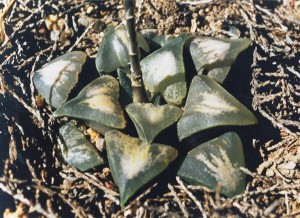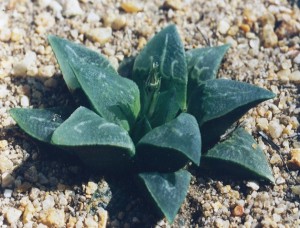During my early years with the Karoo Botanic Garden, in fact it never really got any better, my time spent looking for Haworthia was largely my own. This meant hasty weekend trips, or looking for Haworthia secondarily to other things and more general goals. Also it was a question of scale. I needed to see populations and plants from across the entire distribution range. So those years were spent rather as reconnaissance and in checking all the herbarium and other records. I came across a letter among Major F.R. Long’s papers which put me on the track of a Mr. P.L. Meiring of Bonnievale, south-east of Robertson. This was a copy of a letter from Meiring to Triebner in Windhoek arranging for the collection and purchase of an Haworthia from Drew Station. The result was that 200 plants were sold for the huge price (for those days) of 1s each – allowing for inflation this would have been worth about R14ea in today’s currency.
The plants must have been referred to as H. mutica, or this is simply the general name I was using for what appeared to be a fairly distinctive element south of the Riviersonderend mountains and west of the Breede River. Meiring indicated to me where he had collected the plants and I stopped hastily in that general vicinity he indicated northwest of Drew station. A hurried excursion into the veld and after a short while, I picked up a branch of Renosterbos, and there was a plant. Having confirmed the site, I most uncharacteristically collected this single specimen – something I have never done again. The plant remained in cultivation at the Karoo Garden and is probably still there, while leaf propagules have found their way around the world. Kobus Venter obtained one of these and also still has it in cultivation (Fig.1 JDV92/64). When he started taking an interest in Haworthia in 1985, he set off to look for this mutica. Alas, no success. The site had been cleared and ploughed for a massive centre-point irrigation system. We have many times explored the nearby disturbed and undisturbed patches near there, finding only the odd H. maraisii / heidelbergensis plants and a few H. minima var. poellnitziana. The occurrence of these has given us some hope that H. mutica may still be surviving somewhere there.
Kobus and I discussed the issue and when his plant came into bud, we asked the new owners of Sanddrift, Mr. and Mrs. J. Humby, if we could place the plant in the veld in the vain hope that it would be pollinated. The plant was duly taken there, still in its small pot, and sunk into the ground under the protection of three scraggly Renosterbos plants. When I called there late in September the plant was looking healthy but the developing flower was rather scrawny and too shaded. I broke away a few branches to open it up a little. Late in October I called back and to my astonishment there were three seed capsules. The plant was gleefully taken back to Cape Town and I collected 120 seeds from the three capsules. In my joy I planted half of the seed at once. Alas! It was too early in the summer and too hot for this winter regime dweller. Not learning, I planted another 20 seeds a month later and now have 6 rather spindly seedlings and 20 seeds still to sow.
Sanddrift is a remarkable place as three of the four species of Robustipedunculares grow there in discrete populations, and there are hybrids between both marginata and pumila, and marginata and minima. It is unclear just what relationship heidelbergensis and maraisii enjoy there because elements of both are present too. But now we know that mutica is still there somewhere and we have seed to prove it. The nearest other population is south of the Riviersonderend River more than 15km away (Fig.2a, b & c JDV96/27). Here the plants do not have the purplish-grey tones of the species as I would generalise for it south of the Riviersonderend mountains – but then I never have with any conviction claimed that it is different to H. retusa or H. pygmaea. One of the few specimens from there also evidences the whiteness in the leaves which manifested in the Drew plant many years after its collection. The exposure of our potted plant to its native air and a deposit of dry renosterbos leaves, seem to have given the plant a rejuvenating kick and the accompanying illustration shows how beautiful it looks for its visit home. Sept. 2001 is soon upon us and methinks the White Widow needs the company of her soul mate again. (Note:- in a later Chapter, I describe the rediscovery of H. mutica at Sanddrift, Drew).
Acknowledgement
To Kobus of course for his deep interest in anything going for Haworthia; and then to Beth Humby whose love for anything to do with life and with nature is extraordinary. It was wonderful to have the co-operation of persons who are so enthusiastic and interested. ♦





Pingback: Mystery - part 20, Sandrift - Haworthia Updates
Pingback: ハオルシア ホワイトウィンドウ | 多肉ラブ
I probably will never read the entire contents on this site, but plan on using it as my primary Haworthia reference from now on. I appreciate the time and effort that went into creating the content. Thank you Bruce and whoever else contributed to its creation.